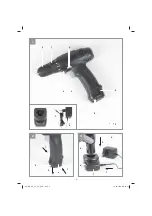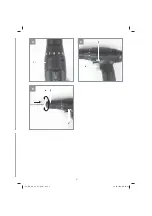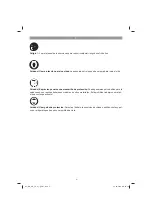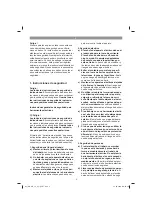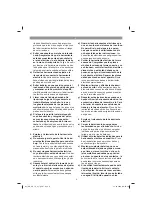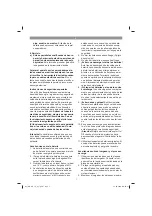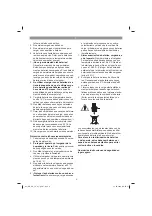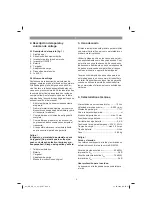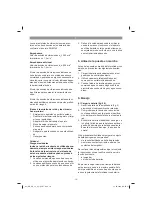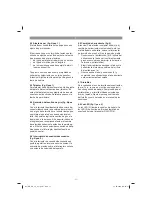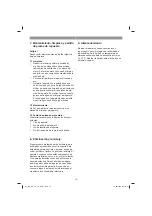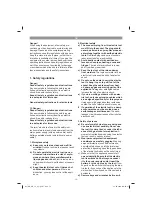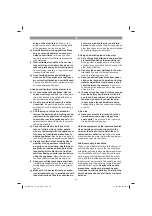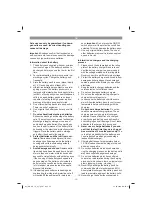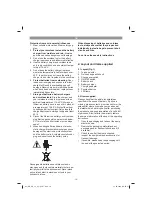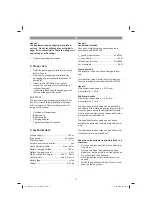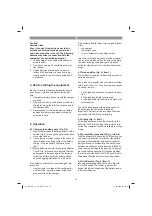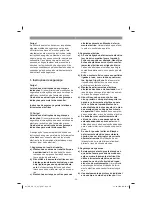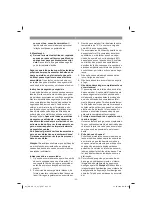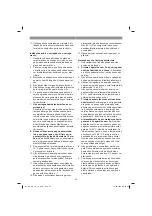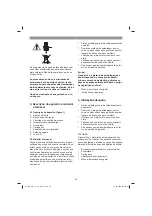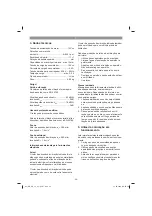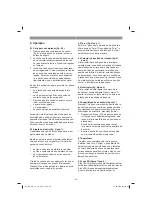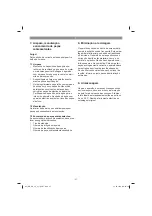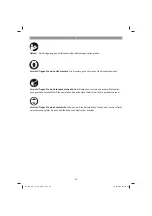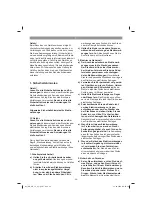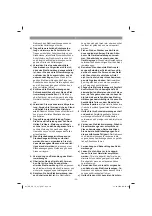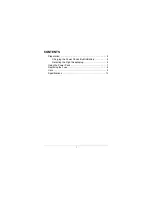
GB
- 15 -
Safe use can only be guaranteed if undama-
ged cells are used. Incorrect handling can
cause cell damage.
Important:
Analyses con
fi
rm that incorrect use
and poor care are the main causes of the damage
caused by high performance batteries.
Information about the battery
1. The battery pack supplied with your cordless
tool is not charged. The battery pack has to
be charged before you use the tool for the
fi
rst
time.
2. For optimum battery performance avoid low
discharge cycles. Charge the battery pack
frequently.
3. Store the battery pack in a cool place, ideally
at 15°C and charged to at least 40%.
4. Lithium-ion batteries are subject to a natural
ageing process. The battery pack must be
replaced at the latest when its capacity falls to
just 80% of its capacity when new. Weakened
cells in an aged battery pack are no longer
capable of meeting the high power require-
ments and therefore pose a safety risk.
5. Do not throw battery packs into an open
fi
re.
There is a risk of explosion!
6. Do not ignite the battery pack or expose it to
fi
re.
7.
Do not exhaustively discharge batteries.
Exhaustive discharge will damage the battery
cells. The most common cause of exhaustive
discharge is lengthy storage or non-use of
partly discharged batteries. Stop working as
soon as the performance of the battery falls
noticeably or the electronic protection system
triggers. Place the battery pack in storage
only after it has been fully charged.
8.
Protect batteries and the tool from over-
loads.
Overloads will quickly result in over-
heating and cell damage inside the battery
housing without this overheating actually
being apparent externally.
9.
Avoid damage and shocks.
Replace batte-
ries which have been dropped from a height
of more than one meter or which have been
exposed to violent shocks without delay, even
if the housing of the battery pack appears to
be undamaged. The battery cells inside the
battery may have su
ff
ered serious damage.
In this respect, please also read the waste
disposal information.
10. If the battery pack su
ff
ers overloading and
overheating, the integrated protective cut-o
ff
will switch o
ff
the equipment for safety rea-
sons.
Important.
Do not press the ON/OFF
switch any more if the protective cut-o
ff
has
actuated. This may damage the battery pack.
11. Use only original battery packs. The use of
other batteries may result in injuries, explosi-
on and a
fi
re risk.
Information on chargers and the charging
process
1. Please check the data marked on the rating
plate of the battery charger. Be sure to con-
nect the battery charger to a power supply
with the voltage marked on the rating plate.
Never connect it to a di
ff
erent mains voltage.
2. Protect the battery charger and its cable from
damage and sharp edges. Have damaged
cables repaired without delay by a quali
fi
ed
electrician.
3. Keep the battery charger, batteries and the
cordless tool out of children’s reach.
4. Do not use damaged battery chargers.
5. Do not use the supplied battery charger to
charge other cordless tools.
6. In heavy use the battery pack will become
warm. Allow the battery pack to cool to room
temperature before commencing with the
charging.
7.
Do not over-charge batteries.
Do not ex-
ceed the maximum charging times. These
charging times only apply to discharged
batteries. Frequent insertion of a charged
or partly charged battery pack will result in
over-charging and cell damage. Do not leave
batteries in the charger for days on end.
8.
Never use or charge batteries if you sus-
pect that the last time they were charged
was more than 12 months previously.
The-
re is a high probability that the battery pack
has already su
ff
ered dangerous damage
(exhaustive discharge).
9. Charging batteries at a temperature below
10°C will cause chemical damage to the cell
and may cause a
fi
re.
10. Do not use batteries which have heated du-
ring the charging process, as the battery cells
may have su
ff
ered dangerous damage.
11. Do not use batteries which have su
ff
ered
curvature or deformation during the charging
process or which show other non-typical sym-
ptoms (gassing, hissing, cracking,…)
12. Never fully discharge the battery pack (re-
commended depth of discharge max. 80%)
A complete discharge of the battery pack will
lead to premature ageing of the battery cells.
13. Never charge the batteries unsupervised.
Anl_RB_CD_12_4_Li_SPK7.indb 15
Anl_RB_CD_12_4_Li_SPK7.indb 15
13.10.2016 08:52:47
13.10.2016 08:52:47


